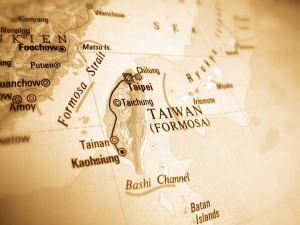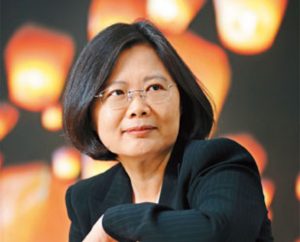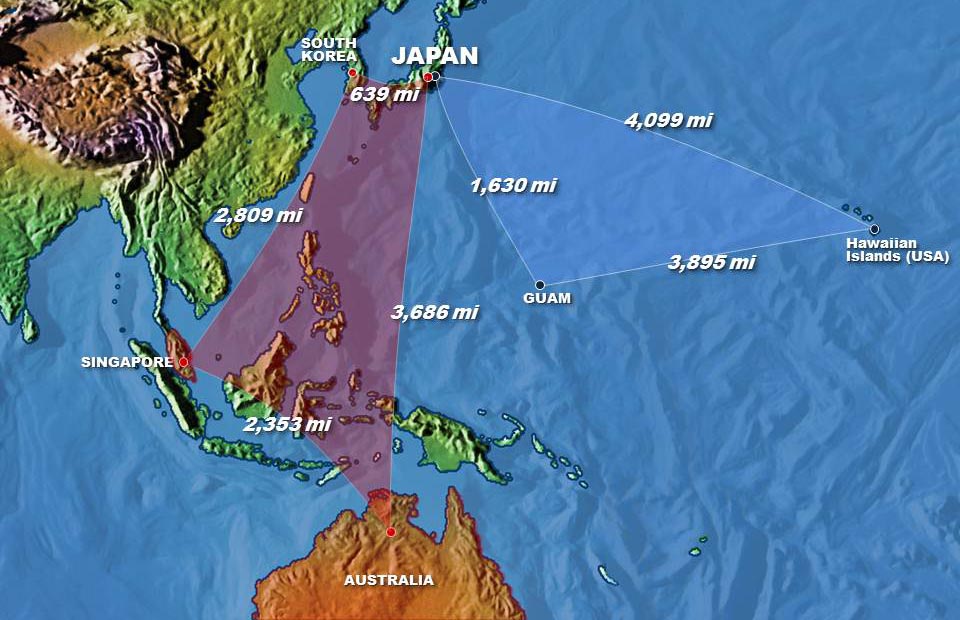The phone call between President-elect Trump and the President of Taiwan has sent shock waves to many in the diplomatic community.
But it is about time to turn the page and include Taiwan in the shaping of a 21st century deterrent strategy for Pacific defense.
The People’s Republic of China has made it clear by its actions and expressed intentions that the regime is moving out into the Pacific and asserting its power and influence and directly threatening U.S. interests and U.S. allies.
It is reaching beyond Taiwan in its military and diplomatic strategy and leveraging its expanded power projection capabilities into the Pacific to reach out to the Japanese Island chains as well as the key maritime access points to Australia.
It is clear how important control of Taiwan would be it shaping a pincer strategy against Japan and Australia and American military installations in the Pacific.
Why would the United States then simply stand by and ignore the defense of Taiwan and its key place in a strategic reshaping of Pacific strategy?
That would be turning the Pacific Pivot into the Pacific Divot.
There is little reason to be frozen in time with Kissinger and Nixon who pursued a strategy rooted in deterrence of the Soviet Union by embracing Communist China, Last time we looked the Soviet Union has collapsed.
Russia is not the Soviet Union in an essential sense of seeing no commonality of relationships with China except and only with regard to realpolitik.
As such, there is little to be gained by appeasing the PRC in hopes of containing Russia. Deterring Russia is a task all unto itself, as it forges a 21st century approach to power, using its military capabilities to shape outcomes seen as essential to Russian national interest by Putin.
http://www.sldinfo.com/remembering-reagan-how-to-deter-the-russians/
Now China is a power unto it itself, one has virtually nothing to do with its condition or role in the global system when Nixon and Kissinger negotiated the Shanghai Communiqué.
As Danny Lam, a Canadian analyst, has underscored:
“Normalization of relations with the PRC was accomplished through the issuance of three communiqués in 1972, 1979, and 1982 that defined the relationship. In those documents, the PRC and US explicitly acknowledged their differences.
“There are essential differences between China and the United States in their social systems and foreign policies.” (para 8, 1972) and made clear that the differences are only papered over temporarily for the sake of peace. Temporarily is the operative word.”
http://www.sldinfo.com/to-whom-do-western-china-experts-owe-their-allegiance/
This was converted to the “one China policy” at the end of the Carter Administration where Carter severed diplomatic relations with Taiwan and recognized the PRC as the sole legitimate government of China. Reagan came to office and rearmed the Shanghai Communiqué.
But Carter’s policy was also forged in the time of battling what is now the non-existent Soviet Union and before China turned into a military power seeking to assert that power deep into the region.
It is time to exit the Madame Tussaud museum of policy initiatives and shape a Taiwan policy for the 21st century, which is part of a broader deterrent strategy.
Both the technology available to the United States and the policy shifts of core allies in the Pacific are enabling the forging of a deterrence in depth strategy.

The Chinese military modernization drive continues to shift the military balance further in Beijing’s favor. How best to include Taiwan in the deterrence in depth strategy? Credit Image: Bigstock
As Japan has focused on its extended defense, Australia upon the integration of its forces with a capability also for the extended defense of Australia and with U.S. forces focus on shaping a force to operate over the extended ranges of the Pacific, now is the time for a serious rebooting of the role of Taiwan in extended Pacific defense and security.
As then MARFORPAC Commander, Lt. General Robling put it with regard to deterrence in depth:
“I like the term deterrence in depth because that’s exactly what it is.
It’s not always about defense in depth.
It’s about deterring and influencing others behavior so they can contribute to the region’s stability, both economically and militarily, in an environment where everyone conforms to the rule of law and international norms.”
U.S. Navy leadership has pioneered the concept of building integrated kill webs which can allow for presence assets to integrate across the extended battlespace to provide for an integrated “no platform fights alone” multi sensor-shooter solutions. Taiwan can be seamlessly integrated in to a Pacific Island deterrence strategy with the political will expressed by President Elect Donald Trump.In our discussions with the new head N-9, Rear Admiral Manazir, he highlighted the key role of shaping integrated forces across a distributed operational area.
It is clear that both the Air Force, the Navy and Marine Corps team are focused on shaping the force for the high-end fight against peer competitors.
The Army’s main contribution in such considerations is the expanding and evolving role of Army Air Defense (ADA) Missile Defense systems. But in so doing, the focus is upon shaping a modular, agile force, which can operate across the spectrum of military operations; not just be honed simply for the high-end fight.
It is about shaping platforms into an integrated force, which can deliver lethal and non-lethal effects throughout the battlespace.
http://breakingdefense.com/2016/10/rear-adm-manazir-speaks-on-allied-force-transformation-a2ad/
It is clear that Taiwan can enter easily into a force structure operating in terms of distributed defense with a deterrence in depth approach. One can start doing so by involving them in various security efforts associated with allied coast guard forces in the region.
They can become a regular participant as a presence force associated with allied and U.S. security operations.
Their involvement with their Air Force and Navy in engaging in partnership in the evolving distributed approach to an integrated Pacific defense strategy is important. And over time their Air Force and Navy can fit into a strategy, clearly designed for defense.

President Tsai Ing-wen, Taiwan’s first woman President.
To defend against a PRC pushing out its military capability into the Pacific, a Taiwan isolated unto itself and NOT part of an overall deterrence in depth force generated by the US, Japan and Australia will simply leave it as a an apple to be plucked from the tree for an aggressive and assertive Beijing government.
President Elect Donald Trump’s phone call put a very powerful marker down for a new chapter in deterring the PRC.
As we wrote in our book on Pacific strategy published three years ago, Taiwan is considered by Beijing from the perspective of holding together their control over the centrifugal forces in their empire; and we can consider as clearly part of a strategy to do the opposite.
“The conflict with Taiwan is subsumed in Chinese thinking as part of the core territorial-integrity challenges.
The Island of Formosa was part of China since its conquest in the Qing Dynasty in the 17th century. It was ceded to Japan in 1895 and returned to China after the war.
In the ensuing Chinese civil war, the forces of Chiang Kai-shek were pushed off the Chinese mainland and relocated to Formosa. Here the Republic of China was established.
Over time, the Republic of China has evolved into a vibrant democracy, and it is the quality of Taiwan as a modern democracy that is a major challenge to the authoritarian Chinese leadership on the mainland.”
Laird, Robbin; Timperlake, Edward; Weitz, Richard (2013-10-28). Rebuilding American Military Power in the Pacific: A 21st-Century Strategy: A 21st-Century Strategy (Praeger Security International) (pp. 25-26). ABC-CLIO. Kindle Edition.
A new Taiwan policy and indeed a new approach to Pacific islands is a key part of any new “constrainment strategy” towards China. Taiwan lies at the juncture of any effective Pacific military strategy with the PRC coming out deeper into the Pacific.
The PRC has changed the nature of the game; Neither Tawian, the United States, Japan nor Australia should accept their encroachment on freedom of the sea in the Western Pacific and South China Sea.
A PRC dominated Taiwan would be militarily poised to disrupt US and allied operations and significantly disrupt the ability to operate in a strategic quadrangle. If the PLA (generic for all PRC military forces) is given time to dig in and build a robust redundant ISR network from survivable hardened ground facilities and dug in and hardened 2nd Arty missiles batteries, it would be a significant new combat challenge.
The PLA combing survivable ISR 100 plus miles off the China coast linked with sea based platforms, PLAAF attack planes, and their satellites (if they are allowed to survive) can be very deadly at sea for the USN and allied forces.
With the PLA propensity for digging, they will literally dig in, and shape combat capabilities at the heart of the strategic quadrangle. It is no wonder that the self-declared ADIZ was yet another round of the PRC trying to assert its reach and affecting Taiwan.
Enhancing the defense of Taiwan is a legitimate right of Taiwan and is permitted by the Taiwan Relations Act. “In furtherance of the policy set forth in section 3301 of this title, the United States will make available to Taiwan such defense articles and defense services in such quantity as may be necessary to enable Taiwan to maintain a sufficient self-defense capability.”
But self-defense of Taiwan against a PRC reaching deep into the Pacific can not be done without shaping interactivity with the US, Japan and Australia and a broader strategic effort.
We can look for ways to both enhance Taiwan’s ability to defend itself and contribute to Pacific defense. One key way would for Taiwan to build up their ISR reach into the area and enhanced C2. These capabilities could evolve as the US Army builds out its Air Defense Artillery or ADA capability in the region.

The US Needs to Operate in Two Strategic Operational Zones: A Triangle In Support of Japan; and a Quadrangle to Support South Korea and Core Asian Allies.
A new way to think about the ADA approach is to build the support facilities throughout the Pacific whereby THAAD and air defense can be supported. THAAD–globally transportable, rapidly deployable capability to intercept and destroy ballistic missiles inside or outside the atmosphere during their final, or terminal, phase of flight. THAAD Weight launch vehicle, fully loaded 40,000kg=88, 184 lbs or 44 short tons.
http://oshkoshdefense.com/variants/m985a4-guided-missile-transporter-gmt/
The Gross Vehicle Weight Rating (GVWR) of missile battery truck alone is 66,000 lbs. Now let us rethink how it might be deployed to remote islands as part of a flexible grid. The CH-53 can take 30,000 lbs internal or sling 36,000 external-range unrefueled is 621 nm. The MV-22 human capacity is 24 combat-loaded Marines-range app 700 miles.
The actual missile battery is 26,000 lbs and well inside the lift capacity of a CH-53.
The problem is the mechanics to raise and lower the battery and rearm. A battery lowered from the air sans truck on reinforced concrete pads with calibrated launch points may make sense. A separate modular lift device could be put in place to load and reload.
Consequently, taking apart modules doesn’t appear to be a showstopper, and Marine MV-22s flying in Army ADA troops into any reasonable terrain is absolutely no problem. The weight of TOC and Radar maybe of concern, and it appears that in todays world there may have been little appreciation by Big Army on using MV-22 and CH-53Ks.
To be very fair the US Vietnam War Army did get it brilliantly by setting up firebases in remote areas with helo lift of very heavy guns. A THAAD island maneuverability concept is the same in principle but with different technology.
Combine ADA Batteries with the ability to move a floating airfield as needed inside the potential sanctuary of a 200+ KM protection umbrella of disbursed island bases with ADA batteries and power projection of the sort needed in Pacific defense is enhanced.
As the US shapes a defensive belt and operates within a strategic quadrangle, Taiwan could be plugged into this belt as it shapes its ISR and C2 capabilities. At some point in the future, Taiwan could operate its own version of ADA and become part of the defensive grid.
The Taiwan Relations Act clearly permits such actions: “To maintain the capacity of the United States to resist any resort to force or other forms of coercion that would jeopardize the security, or the social or economic system, of the people on Taiwan.”
The way ahead is to shape a template, which creates synergy between the self-defense of Taiwan and the evolving US, and allied strategy for deterrence in depth.
President Trump has started the process of setting in motion a new policy. There is the possibility that history may record with Donald Trump taking a phone call from President of Taiwan that just taking the call may resonate with the same moral imperative of “tear down this wall” did for President Reagan in Berlin.
Editor’s Note: This piece was originally published in Breaking Defense.
Taiwan, Trump, & The Pacific Defense Grid: Towards Deterrence In Depth
on December 29, 2016 at 4:00 AM



Leave a Reply